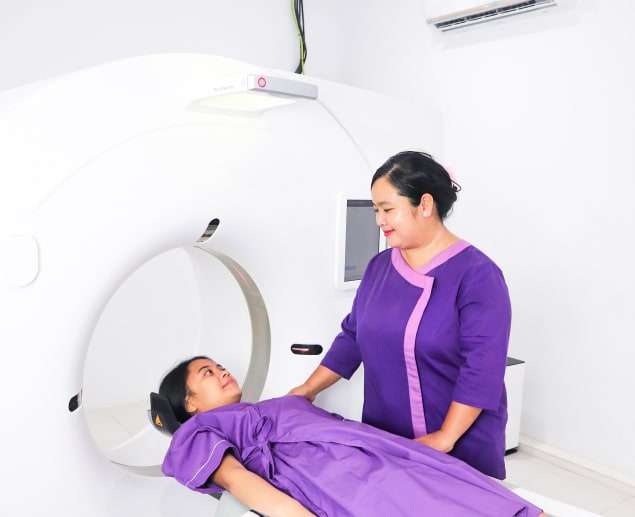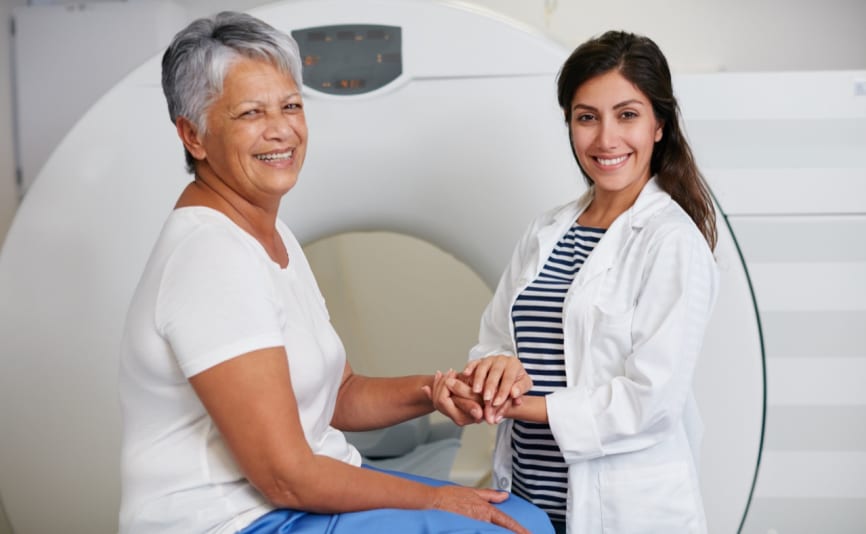Introduction
CT scans provide the gold standard for imaging of the lungs, and they can be used to screen for issues such as lung cancer, and investigate the causes of shortness of breath, chest pain, or, more recently, the effects of long covid.
CT scans aren't without risks - as they use x rays, there is radiation exposure involved and they should not be repeated too often. That's why they are carried out with supervision from your doctor, or in Scan.com's case, one of our experienced clinicians.
However, screening tests can help with the early detection of serious diseases, to maximise treatment options. For lung cancer, these tests are usually in the form of a low dose computerised tomography scan (LDCT scan).
When the benefits and risks are weighed up with guidance from a clinician, they provide a useful tool for investigating lung cancer and other lung-related issues. In this article, we'll take a closer look at the possible benefits and risks of low dose CT scans, how they work, and how you can book your own scan.
What is a CT scan?
CT scans are medical imaging tests, which take photos of the inside of the body from different angles. By studying the images, a specialist doctor called a radiologist can identify health issues that might not be otherwise visible, and patients can use the results to access treatment and onward care.
How does a CT scanner work?
A CT scanner is shaped like a doughnut with a space in the middle. A motorised table moves the patient in and out of the scanner to ensure the correct body area is inside. The scanner emits x ray beams, which circle around the body at high speed, and a receiver on the opposite side of the scanner records the amount of energy that passes through the body. This information can be used to generate images of the chest cavity, lungs, ribs and surrounding tissues.
What is a low dose CT scan?
A low dose computerised tomography scan uses 90% less ionising radiation than a standard CT scan. Typically, a lung cancer screening test will use a spiral or helical CT scan, which creates 3D images of the lungs with high levels of detail and definition.
CT scans are non invasive tests, meaning they don't require surgery or needles. Low dose CT scans also tend not to require any contrast dye to enhance the definition, which would usually be administered via an injection.
Is there a difference between a low dose ct scan and a traditional X ray when screening for lung cancer?
A low dose CT scan generates incredibly detailed images, and can identify lung abnormalities as small as a grain of rice. Meanwhile, a traditional chest x ray captures far less detailed pictures in 2D, and therefore tends to only flag anomalies bigger than the size of a penny.
This means early stage lung cancer can be more easily spotted with a low dose CT scan. A CT scan can also be completed in under a minute, which is generally faster than a traditional X ray.
When would a low dose lung cancer screening be recommended?
An annual lung cancer screening is generally recommended for people with a smoking history - i.e. they either currently smoke or have done in the past. This is because they are at a higher risk of lung cancer, of which smoking is a leading cause.
According to the Preventive Services Task Force in the USA, yearly lung cancer screening should be offered to adults aged 50-80, who:
-
have smoked a pack of cigarettes per day for 20 years, or two packs a day for 10 years.
-
either quit smoking within 15 years, or still currently smoke.
Yearly screenings should be stopped after a patient has stopped smoking for 15 years, has lung cancer found and is undergoing treatment, or if they have another life-limiting condition that would affect their ability to have lung surgery.
Seek advice from your health care providers if you're unsure if a CT scan is the right option for you. If you book a scan with Scan.com, clinician consultations are included within the price for that purpose.
What are the benefits of a lung cancer screening test?
-
Lung cancer screening is three times more likely to spot the disease early. These scan types can identify smaller tumours earlier, making lung cancer treatment more accessible and improving patient outcomes overall.
-
The NHS has released figures to show that with every lung cancer screening, a patient reduces their risk of lung cancer death by 25%. This is because cancers can be spotted while they are more treatable.
What are the risks of a low dose lung CT scan?
-
These scans use radiation, in the form of x rays. Radiation exposure can cause a small increase to a patient's risk of getting cancer in the future, although the low doses required for screening tests are not shown to cause long-term harm.
-
Sometimes, screening scans are criticised for the risk of identifying false positives. A false positive result is where a scan shows the presence of a health condition that may not actually be there. For example, research by the National Cancer Institute has shown around 16% of screenings provide a false positive result, which can cause unnecessary anxiety for patients, along with invasive follow up tests such as a lung biopsy.
It is worth bearing in mind that CT scans are always carried out with guidance from a doctor, radiologist or other healthcare professional.
They carefully consider the safety implications of a scan for a patient. Furthermore, the benefits of CT scanning generally outweigh the increased risk from radiation exposure, especially when early detection of lung cancer can improve treatment outcomes and save lives.
How do I get a lung cancer screening?
The NHS has piloted a targeted lung health check programme, but this is limited to a small number of areas and excludes Scotland, Wales and Northern Ireland. Therefore, lung cancer screening tests are not widely available on the NHS at the moment, and expansion is not expected to be rolled out until after 2024.
Private diagnostic and screening CT scans are available, which can detect cancer. At Scan.com, lung CT scans are available where symptoms such as chest pain, previous anomalies in imaging, or persistent cough are present. All bookings include consultations with experienced clinicians to ensure a CT scan is suitable and safe for each patient.
Lung cancer screening tests are due to be brought online shortly, for smokers and otherwise healthy people who want to check the general health of their lung tissue.
How long does it take to get CT scan results for lung cancers?
Private lung CT scans via Scan.com tend to return results in as little as 48 hours. NHS cancer pathways aim to return results within 1-2 weeks, while screening test results on the NHS can take up to 4 weeks. Waiting for your results can be a nervous time, but it is important to remember that the sooner an issue is found, the better the chances are for treatment.
What will a low dose CT scan of the lungs show?
There are 4 possible results you could receive from a lung screening:
-
No abnormalities found - you will be asked back for another screening in two years.
-
Further scan needed - this means a blur or shadow was spotted on your scan images, but it is likely not to be anything serious and is possibly an error with how the images were taken, rather than a lung problem. You'll be invited back for another scan within three months to make sure it's nothing more serious.
-
Abnormal result - this means an anomaly has been found, and you'll need to be sent for more tests. The majority of people with abnormal results do not have lung cancer, but if your CT scan shows signs of lung cancer, further investigation is required for diagnosis.
-
Incidental finding - this means no sign of lung cancer was found, but something else has been spotted that might need treatment or guidance from your doctor. You should see your GP for further support.
What does cancer look like on a lung scan?
Typically, lung cancers found in low dose CT scan results display as nodules - rounded, irregular opacities (or shadows) measuring up to 3cm across.
If you have a traditional CT scan using contrast, cancer would tend to show in a brighter white colour, which helps radiologists to spot an anomaly.
However, further tests are required to definitively diagnose cancer. This is because depending on the type of scan you have, a mass may look like a tumour, but could in fact be a cyst, or benign (non-cancerous) lump.
Is there anything I can do to reduce my risk of lung cancer?
Stopping smoking, or not starting to smoke at all, are the best things you can do to reduce your risk of lung cancer. Cigarette smoking is the number one cause of lung cancer, and is linked to 80-90% of cases of the disease in the USA. If you already have a smoking history, it's not too late to quit, and stopping now will reduce your risk of lung cancer.
Sometimes, you might experience symptoms such as shortness of breath, fatigue, weight loss, persistent cough, or chest pain. While this is likely not lung cancer and could be attributed to a different health problem, it is important to get checked for your symptoms. While a screening test isn't designed to completely prevent cancer, it can catch it earlier and improve treatment outcomes. That's why it's important that otherwise healthy people keep an eye on their health and seek advice for symptoms early.
Next steps
For more resources about CT scans, visit our Private CT Scan Services page
Or, head to our Health Hub for more articles about imaging and healthcare
Sources used
https://www.cancerresearchuk.org/about-cancer/lung-cancer/getting-diagnosed/lung-health-checks
https://respiratory-research.biomedcentral.com/articles/10.1186/s12931-018-0716-0
https://www.ncbi.nlm.nih.gov/pmc/articles/PMC5537112/
https://www.ncbi.nlm.nih.gov/pmc/articles/PMC5144111/
https://www.ncbi.nlm.nih.gov/pmc/articles/PMC4877352/
https://www.nhs.uk/conditions/ct-scan/
https://www.cancer.gov/types/lung/hp/lung-screening-pdq#_227
https://www.uspreventiveservicestaskforce.org/uspstf/recommendation/lung-cancer-screening
https://www.cdc.gov/cancer/lung/basic_info/risk_factors.htm
https://www.cancercenter.com/diagnosing-cancer/diagnostic-imaging/ct-scans






